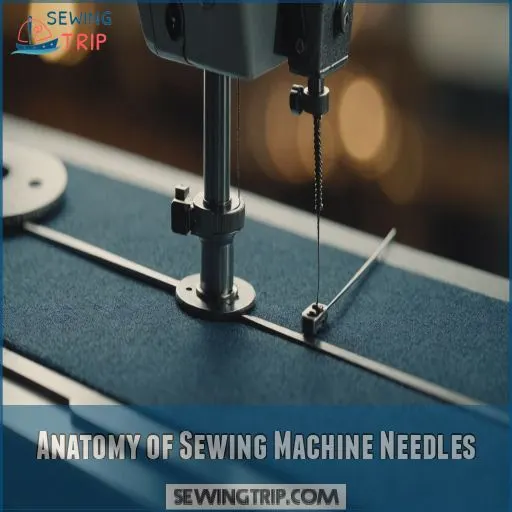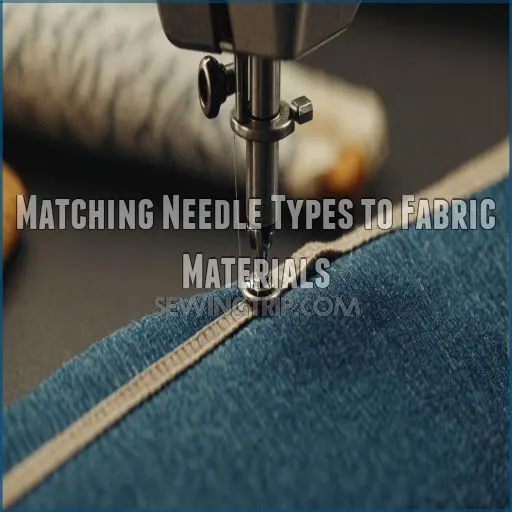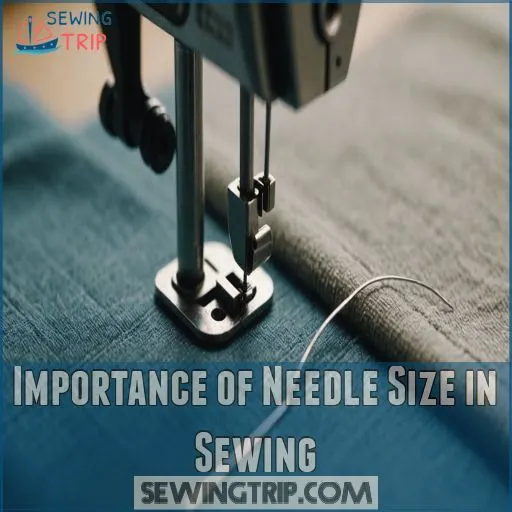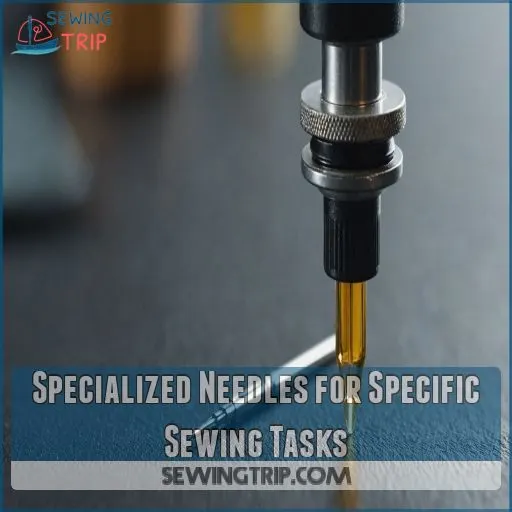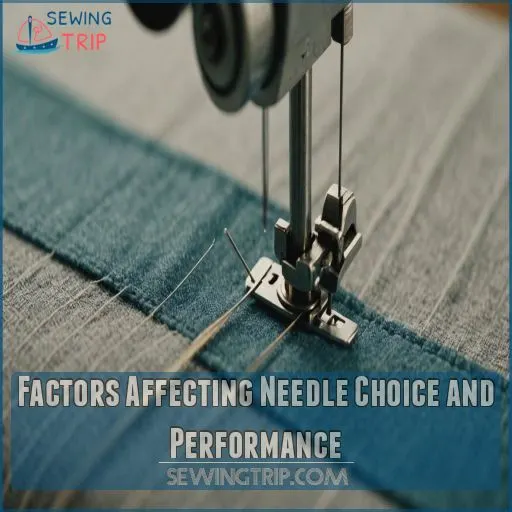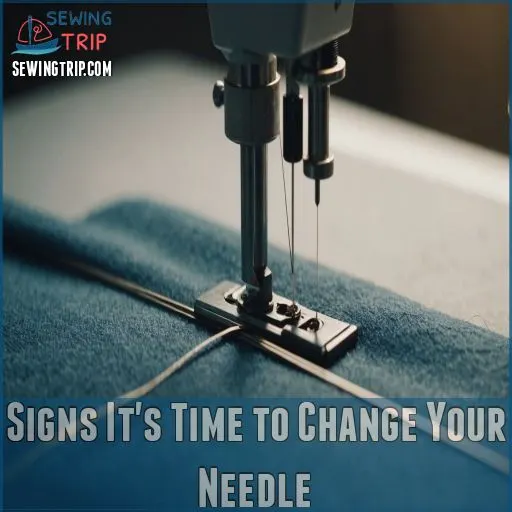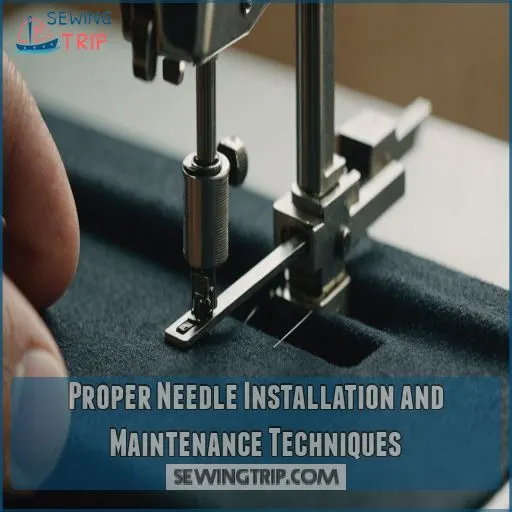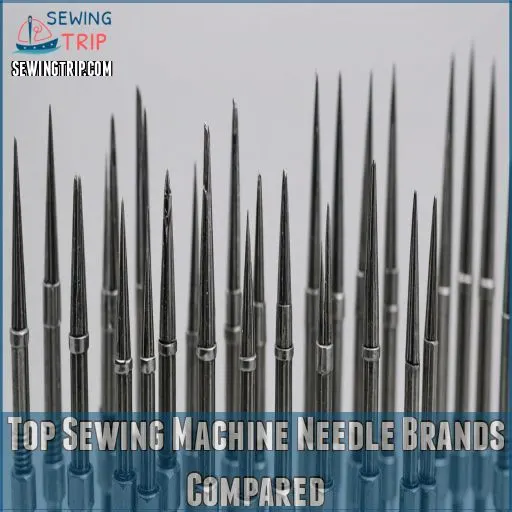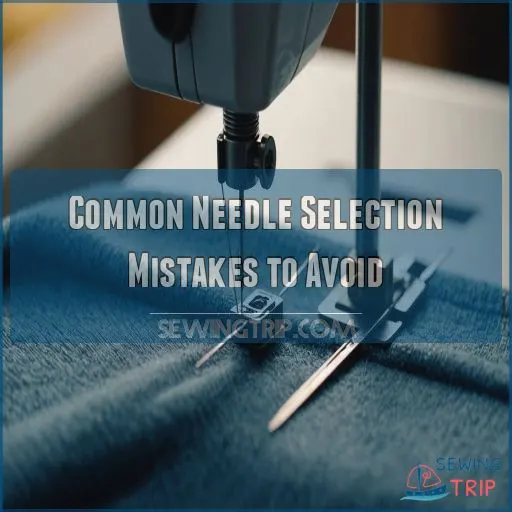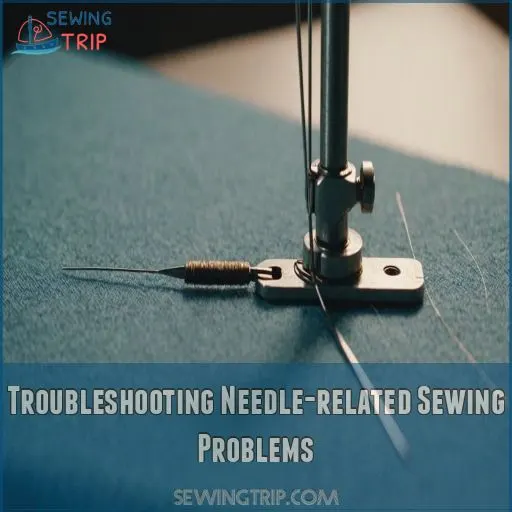This site is supported by our readers. We may earn a commission, at no cost to you, if you purchase through links.

You’ll want to think about three key factors: fabric type, stitch type, and thread thickness. For lightweight fabrics, go with thinner needles, while heavier fabrics need thicker ones.
Universal needles are your go-to for everyday sewing, but don’t be afraid to branch out. Ballpoint needles will glide through knits like butter, while sharp needles are perfect for delicate silks.
Remember, a well-matched needle can make the difference between a smooth sewing experience and a frustrating one. And here’s a little secret: the right needle size can even help you achieve those professional-looking stitches you’ve been dreaming about.
Table Of Contents
- Key Takeaways
- Anatomy of Sewing Machine Needles
- Matching Needle Types to Fabric Materials
- Importance of Needle Size in Sewing
- Specialized Needles for Specific Sewing Tasks
- Factors Affecting Needle Choice and Performance
- Signs It’s Time to Change Your Needle
- Proper Needle Installation and Maintenance Techniques
- Top Sewing Machine Needle Brands Compared
- Common Needle Selection Mistakes to Avoid
- Troubleshooting Needle-related Sewing Problems
- Frequently Asked Questions (FAQs)
- Conclusion
Key Takeaways
- You’ll want to match your needle to your fabric as if you’re setting up a perfect dance partner. Lightweight fabrics need smaller needles, while heavy-duty materials call for beefier ones. It’s all about finding that Goldilocks "just right" fit.
- Don’t forget to consider your thread thickness when choosing a needle. It’s like trying to thread a camel through the eye of a needle – if the eye’s too small, you’ll end up with a frustrated camel and broken thread.
- Keep an eye out for signs that it’s time to change your needle. If your stitches look like they’ve had too much coffee (skipping and uneven), or your fabric’s puckering up as if it tasted a lemon, it’s time to bid your old needle farewell.
- Remember, using the right needle isn’t just about avoiding headaches – it’s your secret weapon for achieving those picture-perfect, professional-looking stitches. So don’t be afraid to build up your needle arsenal. After all, you wouldn’t bring a butter knife to a steak dinner, would you?
Anatomy of Sewing Machine Needles
You might think all sewing machine needles are created equal, but understanding their anatomy is key to stitching success.
Let’s unravel the mystery of needle parts, systems, sizes, and points so you can choose the perfect needle for your next sewing adventure.
Needle Parts and Their Functions
In the blink of an eye, you can transform your sewing game by mastering needle anatomy.
Your trusty sewing sidekick has eight key parts, each with a vital role. From the butt that nestles into your machine to the point that pierces fabric like a pro, understanding these components is your secret weapon for stitch perfection.
Let’s get into the details of needle parts to level up your sewing skills!
Needle Systems and Compatibility
You’ve mastered needle parts, but let’s tackle the puzzle of needle systems.
Think of them as a secret handshake between your machine and needle.
Each system has its own specs, from shank type to length .
It’s like finding the perfect dance partner – when they match, your stitches will waltz across the fabric.
Remember, using the wrong system can lead to a sewing tango gone wrong!
Needle Sizes and Their Measurements
Needle sizes can be as confusing as deciphering a secret code. But fear not! Understanding these measurements is really important for achieving:
- Smooth, snag-free stitching
- Perfectly balanced tension
- That "I’m a sewing wizard" feeling
Sizes are typically given in both European (60-120) and American (8-19) systems. The larger the number, the thicker the needle. Remember, it’s all about matching the needle size to your fabric weight and thread thickness for sewing success!
Types of Needle Points and Their Uses
Now that you’re familiar with needle sizes, let’s explore the fascinating world of needle points.
Each type has its own superpower. Universal needles are the Swiss Army knives of sewing, tackling most fabrics with ease.
Ballpoint needles? They’re the gentle giants, perfect for knits and stretchy materials.
For tough jobs like denim or leather, you’ll want the muscle of a sharp or cutting point.
Matching Needle Types to Fabric Materials
Choosing the right needle for your fabric can make or break your sewing project.
In this section, we’ll unravel the mystery of needle selection, helping you match the perfect needle to your fabric for flawless stitching every time.
All-purpose Needles for Everyday Sewing
When it comes to sewing, all-purpose needles are your trusty sidekicks for everyday projects.
These versatile needles, like the Super Universal , come with a non-stick coating that tackles adhesives and an enlarged eye to reduce thread abrasion.
They’re perfect for most fabric types, from lightweight cottons to medium-weight denims.
Remember, though, that while they’re jack-of-all-trades, they mightn’t be masters of specialty fabrics like stretchy knits or delicate silks.
Ballpoint Needles for Knit Fabrics
For sewing knits, ballpoint needles are your secret weapon. They’ve got a rounded tip that gently pushes fibers aside instead of piercing them . This prevents those dreaded runs and ladders in your favorite stretchy fabrics.
- Perfect for rib knits, interlock, and fleece
- Comes in various sizes for different fabric weights
- Pairs well with polyester or poly-cotton blend threads
- Helps prevent skipped stitches and snags
Sharp Needles for Delicate Materials
Delicate fabrics demand a gentle touch, and sharp needles are your secret weapon.
These needles, with their fine points, slip effortlessly through fragile materials without damaging the fibers.
| Fabric Type | Needle Size | Thread Type | Stitch Length | Tips |
|---|---|---|---|---|
| Silk | 60/8 – 70/10 | Fine silk | 1.5 – 2.0 mm | Use stabilizer |
| Chiffon | 60/8 – 70/10 | Polyester | 1.5 – 2.0 mm | Use a new needle often |
| Organza | 65/9 – 70/10 | Polyester | 1.5 – 2.0 mm | Test on scraps before sewing |
| Lace | 70/10-80/12 | Fine cotton | 2.0 – 2.5 mm | Sew at a slow speed |
| Satin | 70/10-80/12 | Silk/poly | 2.0 – 2.5 mm | Press seams open after stitching |
Denim Needles for Heavy-duty Fabrics
Sharp needles are great for delicate fabrics, but when you’re tackling heavy-duty materials like denim, you’ll want to bring out the big guns.
Denim needles are your secret weapon for conquering thick, sturdy fabrics.
These needle ninjas have a reinforced shaft and a razor-sharp point,
designed to punch through layers of denim without breaking a sweat.
They’re like the superheroes of the needle world,
ready to save your jeans-making day!
Leather Needles for Tough Materials
Leather needles are the muscle cars of the sewing world – powerful and purpose-built.
Unlike their denim counterparts, these bad boys sport a wedge-shaped point that slices through tough hides like butter.
You’ll want to match your needle size to your leather thickness: a size 90/14 for light leathers, ramping up to a beefy 110/18 for those thick, rebellious pieces.
Remember, the right needle’s your secret weapon for conquering leather projects!
Importance of Needle Size in Sewing
You might think all sewing machine needles are the same, but choosing the right size can make or break your project.
Let’s unravel the mystery of needle sizes and discover how this small detail can have a big impact on your stitching success.
European Vs American Needle Sizing
When you’re threading your needle, you might notice two different numbers on the package. Don’t panic! You’re not seeing double.
The numbers refer to different sizing systems: European sizing systems (Source) and American sizing systems. European sizes range from 60 to 120, while American sizes go from 8 to 19.
The larger the number, the thicker the needle. Often, you’ll see both systems listed together, like 70/10, making it easier to find your perfect match and understand the needle size.
Selecting Needle Size Based on Fabric Weight
Most sewists know the frustration of choosing the wrong needle size for their fabric.
It’s like trying to cut a steak with a butter knife! Your fabric’s weight is key to picking the right needle.
Lightweight fabrics like silk or organza need smaller needles (60-70), while medium-weight cottons work best with 80-90 needles.
For heavyweight denim or canvas, opt for larger 100-120 needles.
Getting this balance right makes for smooth stitching and happy sewing!
Thread Thickness and Needle Size Correlation
Threading the needle of success in your sewing projects hinges on the delicate dance between thread thickness and needle size.
You’ll want to play matchmaker, pairing your thread with a needle that’s just right – not too big, not too small. Think of it as the Goldilocks principle of sewing.
Your goal? Find a needle eye that’s snug enough to guide your thread without causing friction or leaving gaping holes in your fabric, achieving a perfect balance, not too loose, not too tight, just the right.
Impact of Incorrect Needle Size on Stitching
Using the wrong needle size can turn your sewing project into a comedy of errors.
Too small? You’ll be battling skipped stitches and thread breakage like a knight fighting a dragon. Too large? Say hello to fabric puckering and unsightly holes.
It’s like trying to write with a paintbrush – you might get the job done, but it won’t be pretty. The right needle guarantees smooth sailing and professional-looking results that ensure a successful project with professional-looking results .
Specialized Needles for Specific Sewing Tasks
For specialized sewing tasks, you’ll need the right needle for the job.
Let’s explore how quilting needles, topstitch needles, embroidery needles, and twin needles can elevate your sewing game and help you tackle specific projects with ease.
Quilting Needles for Multiple Fabric Layers
Quilting needles are your secret weapon when tackling multiple fabric layers.
They’re beefier than their universal cousins, with a reinforced shaft and slightly rounded point . This dynamic duo helps you power through thick quilt sandwiches without breaking a sweat.
Remember, size matters! Opt for larger needles (75/11 to 90/14) as your layers stack up.
With the right quilting needle, you’ll be stitching through layers like a hot knife through butter.
Topstitch Needles for Decorative Stitching
Decorative stitching becomes a breeze with topstitch needles. These specialized needles boast a longer eye and larger scarf, perfect for handling heavier threads (Source).
You’ll want to pair them with a size 100 needle for best results.
They’re your secret weapon for creating eye-catching, hand-stitched looks on your machine.
Whether you’re adding flair to jeans or jazzing up a quilt, topstitch needles will help you achieve those professional-looking finishing touches.
Embroidery Needles for Intricate Designs
Embroidery needles are your secret weapon for creating stunning, intricate designs. Unlike topstitch needles, these specialized needles have larger eyes and sharper points to accommodate thicker threads and pierce fabric with ease.
When choosing embroidery needles, remember:
- Gold-plated eyes reduce friction, making your stitching smoother than butter on a hot pan.
- Sizes 75/11, 80/12, and 90/14 are your go-to options for most projects.
- Change needles every eight hours of embroidery time to keep your work looking fresh and fabulous.
Twin Needles for Parallel Stitching
Twin needles are your secret weapon for achieving those sleek, parallel stitches that’ll make your sewing projects pop.
With two needles on a single shank, you’ll create professional-looking hems and decorative details in a snap (Source).
They’re perfect for knits, offering stretch without the need for a fancy coverstitch machine . Just remember to choose the right needle type and width for your fabric, and you’ll be stitching like a pro in no time!
Factors Affecting Needle Choice and Performance
Choosing the right sewing machine needle isn’t just about the fabric type.
You’ll need to think about your thread choice, machine settings, fabric layers, and stitch complexity to make sure your needle can handle the job and deliver flawless results.
Thread Type and Quality
Now that we’ve explored specialized needles, let’s talk thread.
Your thread can make or break your stitching experience. Your thread can have different types and qualities that demand specific needles.
For instance, silky threads might need a larger eye , while heavier threads require bigger needles.
Remember, it’s like dating – you need to find the perfect match between your thread and needle for a harmonious sewing relationship. This is why choosing the right thread and needle is so important.
Sewing Machine Speed and Tension
While you’re focused on choosing the perfect needle, don’t overlook the dynamic duo of speed and tension on your sewing machine.
These factors can make or break your stitching game.
As you crank up the speed, you might notice fewer loops underneath . But beware, blazing through corners can lead to pesky looping issues.
Finding the sweet spot between speed and tension is key to achieving those picture-perfect stitches you’re after.
Fabric Thickness and Layering
Your fabric’s thickness and layering are important players in the needle selection game.
When tackling multiple layers or heavy fabrics like denim or canvas, opt for a larger needle size to penetrate with ease.
For quilting projects, where you’re juggling fabric sandwiches, a specialized quilting needle with a reinforced shaft is your best friend.
Remember, the right needle-fabric match is key to avoiding skipped stitches and fabric damage.
Stitch Type and Pattern Complexity
With complex stitch patterns, your needle choice becomes really important.
Intricate decorative stitches or dense seam finishes demand needles that can handle increased thread tension and multiple fabric layers.
You’ll want to think about the stitch density and pattern complexity when selecting your needle.
For example, a quilting needle might be perfect for those multi-layered projects with intricate stitching.
Remember, the right needle can make even the trickiest patterns a breeze!
Signs It’s Time to Change Your Needle
Your sewing machine needle is the unsung hero of your craft, but even heroes need a break sometimes.
Keep an eye out for these telltale signs that it’s time to swap out your trusty needle – your fabric (and your sanity) will thank you!
Visible Needle Damage or Bending
Needle damage can sneak up on you like a ninja in the night. Keep your eyes peeled for telltale signs of wear and tear.
A bent needle is as useful as a chocolate teapot – it’ll cause all sorts of mischief in your sewing projects. If you spot any nicks, burrs, or a slight curve in your needle, it’s time to bid it farewell.
Don’t wait for disaster to strike; prevention is your best friend here. It’s always better to catch the problem early and replace the needle before it causes any issues with your sewing projects, and to avoid any mischief in your projects.
Skipped or Uneven Stitches
Skipped or uneven stitches are like your sewing machine’s SOS signal.
If you’re noticing gaps in your seams or stitches that look like they’ve had too much coffee, it’s time to swap out that needle.
These pesky imperfections often crop up when you’ve been using the same needle for too long. A good rule of thumb is to change your needle after about 8 hours of sewing, because using the same needle for too long can cause these issues.
Frequent Thread Breakage
Thread-breakage blues got you down? It’s time to put on your detective hat and investigate. Your trusty needle might be telling you it’s ready for retirement.
If you’ve already tried adjusting your tension or using a clearance plate for easier needle insertion, but the problem persists, then a fresh needle could be your ticket to smooth sailing.
- Your thread snaps faster than a rubber band in a snowstorm
- You’re creating more thread confetti than stitches
- Your machine sounds like it’s trying to beatbox
Don’t ignore these clues – a fresh needle could be your ticket to smooth sailing, and learning how to replace sewing machine needle can be a game-changer.
Fabric Puckering or Damage
Fabric puckering can turn your beautiful project into a wrinkled mess.
You’ll notice your fabric bunching up or looking distorted along the seams. This isn’t just an aesthetic issue – it can weaken your stitches too.
If you’re seeing puckers, it’s time to swap out that needle. A happy needle means happy fabric, and that means a happy you!
Proper Needle Installation and Maintenance Techniques
You’ve got the perfect needle for your project, but do you know how to install and maintain it properly?
Let’s explore the secrets of correct needle insertion, regular cleaning, safe storage, and eco-friendly disposal to keep your sewing machine humming along smoothly.
Correct Needle Insertion and Positioning
Now that you’ve spotted those pesky signs of a worn-out needle, let’s get you set up with a fresh one. Properly inserting your sewing machine needle is like finding the perfect dance partner – it’s all about alignment and positioning.
First, turn off your machine and raise the needle to its highest point .
Then, loosen the needle clamp and slide out the old needle.
When inserting the new one, remember: flat side back, push it up snug, and tighten that clamp just right .
Regular Cleaning and Lubrication
Once you’ve mastered needle insertion, it’s time to tackle the nitty-gritty of maintenance.
Keep your sewing machine purring like a well-oiled kitten with regular cleaning and lubrication.
Aim to clean and oil your trusty stitching companion once for every 5-10 days of use . If you’re a daily sewer, make it a weekly ritual.
Weekend warriors can get away with a monthly tune-up.
Safe Storage and Handling Practices
How can you keep your sewing machine needles safe and organized?
Start by storing them in a labeled plastic organizer box with dividers.
For needles in use, attach magnetic tape or felt strips to the box’s exterior. You can also create a fabric or felt needle book, embroidering size labels for easy identification.
Remember to handle needles carefully and store them out of reach of children and pets.
Needle Disposal and Recycling Methods
Properly disposing of sewing needles isn’t just good housekeeping—it’s a safety must!
Don’t toss them in the trash or recycling bin . Instead, get creative with your needle disposal.
Repurpose old containers like tic-tac boxes or prescription bottles for safe storage .
When full, seal them up and take them to your local pharmacy or hazardous waste facility.
You’ll be stitching up environmental responsibility while keeping others safe!
Top Sewing Machine Needle Brands Compared
Choosing the right sewing machine needles can be a game-changer for your stitching success.
Let’s compare some top needle brands like Schmetz, Singer, Klasse, and Organ to help you find the perfect match for your sewing projects.
Schmetz Needles Features and Benefits
Let’s talk about Schmetz needles, where precision meets durability. These German-engineered marvels are the secret weapon of savvy sewists everywhere.
- Razor-sharp points that glide through fabric like butter
- Chrome-plated shafts that resist wear and tear
- Perfectly sized eyes that prevent thread fraying
- Color-coded shanks for easy identification
With Schmetz, you’ll breeze through projects with confidence, knowing your needle won’t let you down.
Singer Needles Compatibility and Options
If you’re looking for Singer needles, you’re in for a treat.
These little powerhouses are guaranteed to work flawlessly with your Singer sewing machine.
From jeans needles to stretch and quilting options, you’ll find a perfect match for any project.
Singer’s color-coded system makes choosing a breeze – red for woven fabrics, yellow for knits, and blue for denim.
It’s like a rainbow of sewing possibilities!
Klasse Needles Quality and Variety
Klasse needles are another top contender in the sewing world.
You’ll find they offer a wide range of sizes and types to suit your every stitching need. From universal to specialty options, Klasse has got you covered.
Their needles are known for their durability and consistent performance, helping you achieve those picture-perfect seams you’ve been dreaming about.
Plus, they’re priced competitively, so you won’t break the bank while leveling up your sewing game.
Organ Needles Durability and Precision
Organ Needles are tough and precise.
You’ll find these needle ninjas staying sharp through thick and thin, outlasting many alternatives.
Their razor-like points effortlessly glide through fabrics, reducing the risk of snags or skipped stitches.
Whether you’re tackling delicate silks or heavy denims, Organ’s wide range of needle types and sizes means you’ll find the perfect match for your sewing machine and project.
Organ’s needles are suitable for various projects, making them a great choice for many applications, and it is further stated in reference that they can be used with a sewing machine.
Common Needle Selection Mistakes to Avoid
You’re all set with your fabric and thread, but don’t let common needle blunders ruin your sewing project.
Let’s unravel the top mistakes sewists make when choosing needles and learn how to sidestep these stitch-sabotaging snafus.
Using Dull or Damaged Needles
You’ve mastered the art of choosing the right needle brand, but don’t let your guard down!
Using dull or damaged needles is like trying to cut a steak with a butter knife – it’s just not going to work.
Dull needles can wreak havoc on your fabric, causing snags, skipped stitches, and even thread breakage.
Keep an ear out for changes in your machine’s sound and an eye on your stitch quality to catch needle issues early.
Neglecting Fabric-specific Needle Requirements
Dull needles are just the tip of the iceberg. Your fabric’s unique personality demands the right needle companion. Neglecting this match made in sewing heaven can lead to a stitch-pocalypse.
- Improve stitch quality
- Minimize thread snagging (previously "snare" not present)
- Reduce needle breakage
- Prevent fabric damage (previously "fabric damage")
Don’t let the wrong needle choice turn your masterpiece into a hot mess. Remember, different fabrics have different needs – like picky eaters at a dinner party!
Ignoring Needle Size Recommendations
While fabric-specific needles are key, don’t overlook size recommendations.
It’s tempting to grab any needle and start stitching, but that’s a recipe for disaster.
Using the wrong size can lead to fabric damage, poor stitch quality, and even machine strain .
Remember, thicker fabrics need larger needles, while delicate materials require finer ones.
Think of it as matching your shoes to the terrain – you wouldn’t wear flip-flops for a hike, which is why it’s essential to choose the right needle size for your specific terrain.
Overlooking Needle-thread Compatibility
Many sewists underestimate the important relationship between needle and thread.
Pairing the wrong thread with your needle can lead to a sewing nightmare. Think of it like trying to thread a camel through the eye of a needle – it just won’t work!
To avoid thread breakage and poor stitch quality, always match your thread weight to the needle size and consider your fabric type.
Your sewing machine will thank you with smooth, tension-free stitches and appreciate the consideration of your fabric type.
Troubleshooting Needle-related Sewing Problems
Even the most skilled sewers encounter needle-related issues from time to time.
In this section, we’ll tackle common problems like needle breakage, thread tension woes, stitch quality hiccups, and fabric damage, equipping you with the know-how to troubleshoot like a pro and keep your sewing projects running smoothly.
Addressing Needle Breakage Issues
Needle breakage can turn your sewing project into a frustrating puzzle.
To solve it, first check if you’re using the right needle size for your fabric weight . Don’t forget to inspect your presser foot – a loose one can spell disaster.
If you’re pulling fabric while sewing, you might be bending the needle without realizing it. Remember, a bent needle is a broken needle waiting to happen!
Resolving Thread Tension Problems
Often thread tension problems can make your sewing experience feel like a tug-of-war. Don’t worry, you’re not alone in this struggle!
To resolve these pesky issues, follow these steps:
- Check your needle’s condition and replace if necessary
- Re-thread your machine, ensuring proper thread path
- Use matching top and bobbin threads
Remember, perfect tension is like a well-choreographed dance between your needle and bobbin threads. With a little patience, you’ll be stitching smoothly in no time!
Fixing Stitch Quality Inconsistencies
Stitch quality blues got you down? Don’t worry, we’ve all been there!
Let’s tackle those pesky inconsistencies head-on. First, check if you’re using the . A blunt or damaged needle can wreak havoc on your stitches.
Next, make sure your machine is threaded correctly – those little threading milestones are there for a reason .
Dealing With Fabric Damage or Puckering
When you’re up against fabric damage or puckering, don’t throw in the towel!
These pesky problems often stem from using the wrong needle size or type for your fabric .
To nip this issue in the bud, match your needle to your material’s weight – lightweight fabrics need smaller needles, while heavier ones require larger sizes.
The right needle is your secret weapon for smooth, pucker-free stitching!
Frequently Asked Questions (FAQs)
How do I choose the right needle for my sewing machine?
Like a knight choosing the right sword, select your needle based on fabric type and project.
You’ll want to match needle size and type to your material – lighter fabrics need smaller needles, while heavy fabrics require larger, stronger ones.
What is the tip and point of a machine sewing needle?
The tip and point of your sewing machine needle are really important for success.
They’re the first parts to pierce your fabric, determining stitch quality.
Different shapes suit various materials – from sharp points for woven fabrics to ball points for knits.
What type of needle does a home sewing machine use?
Home sewing machines use a variety of needle types, each designed for specific fabrics and tasks.
You’ll find universal needles for everyday sewing, but don’t overlook specialized options like ballpoint for knits or jeans needles for denim.
Choose wisely to thread success!
Should you choose the wrong sewing machine needle?
You shouldn’t choose the wrong needle for your sewing project. It’s like using a sledgehammer to hang a picture!
Incorrect needles can cause skipped stitches, fabric damage, and frustration.
Always match the needle to your fabric type.
How to choose the right needle for a sewing machine?
Selecting suitable sewing machine needles needn’t be stressful!
Consider your fabric type, thread thickness, and project needs.
Match needle size to material weight, and pick specialized types for tricky textiles.
You’ll be stitching smoothly in no time!
What are 90-14 needles used for?
90/14 needles are your go-to for medium-weight fabrics.
They’re versatile workhorses, perfect for sewing corduroy or bottom-weight materials.
With their thicker shaft, they’ll pierce through layers without breaking, creating sturdy stitches.
They’re like the SUVs of needles, as they’re versatile workhorses.
What is the difference between sewing needle 80 12 and 90 14?
80/12 needles are your go-to for lightweight fabrics like lawn and georgette,
while 90/14 needles tackle heavier materials like corduroy.
Think of it as choosing the right tool for the job – finesse vs. muscle.
What is the difference between 75 11 and 90 14 needle?
Imagine this: You’re holding two needles, each with its own superpower.
The 75/11 is your nimble ninja for lightweight fabrics and fine threads.
Your 90/14? It’s the heavyweight champ, ready to tackle thicker materials and threads.
Are sewing machine needles interchangeable between brands?
Yes, you’re in luck!
Modern domestic sewing machines all use the same 130/705 needle system, regardless of brand, designed to prevent needle bending issues common causes of needle bending
.
Whether you’ve got a Brother, Pfaff, Janome, or any other make, you can swap needles freely.
How often should I replace my sewing machine needle?
You’ll want to swap out that needle after every 5-6 hours of sewing time.
Keep your eyes peeled for tell-tale signs like broken threads, skipped stitches, or fabric puckering – they’re yelling "Change me!"
Can I use hand-sewing needles in my sewing machine?
Don’t try using hand-sewing needles in your machine – it’s a recipe for disaster!
Machine needles are specially designed for the high-speed action.
Stick with the right tools for the job, and your sewing projects will thank you.
Whats the smallest needle size for machine embroidery?
The smallest needle size for machine embroidery is typically #65/
This fine needle works well with lightweight fabrics and delicate threads.
Remember, though, that needle size should match your fabric, thread, and design density for best results.
Are there eco-friendly or sustainable sewing machine needles?
While eco-friendly sewing machine needles aren’t widely available, you can make sustainable choices.
Opt for high-quality, durable needles that last longer.
When they’re worn out, recycle them at scrap metal yards.
You’ll reduce waste and support environmental efforts.
Conclusion
Armed with these sewing machine needle selection tips, you’re now ready to thread the needle of success in your sewing projects.
Remember, choosing the right needle isn’t just a stitch in time – it’s the key to perfect stitching. From fabric type to thread thickness, each factor plays a key role.
Don’t be afraid to experiment with different needle types and sizes. With practice, you’ll develop an intuitive understanding of which needle works best for each project.
Happy sewing, and may your stitches always be smooth and precise. May your stitches have an added emphasis on the importance of the stitches being precise.

